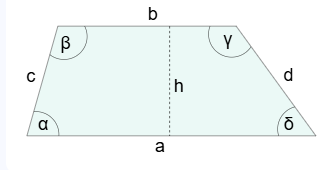1. What is an Area of a Trapezoid Calculator?
Definition: This calculator computes the area, perimeter, and angles (\( \alpha \), \( \beta \), \( \gamma \), \( \delta \)) of a trapezoid given its bases \( a \) (bottom) and \( b \) (top), height \( h \), and legs \( c \) (left) and \( d \) (right). A trapezoid is a quadrilateral with at least one pair of parallel sides (the bases). The calculator supports length units (mm, cm, m, in, ft, yd) and area units (mm², cm², m², in², ft², yd²), defaulting to m for inputs and lengths, and m² for area.
Purpose: It aids in geometry education and practical applications by calculating key properties of trapezoids, useful in fields like architecture, engineering, and design for shapes like roofs or land plots.
2. How Does the Calculator Work?
The calculator uses the following formulas for a trapezoid with bases \( a \), \( b \), height \( h \), and legs \( c \), \( d \):
- Area: \( A = \frac{(a + b) \cdot h}{2} \)
- Perimeter: \( P = a + b + c + d \)
- Angle \( \alpha \): \( \alpha = \arcsin\left(\frac{h}{c}\right) \cdot \frac{180}{\pi} \)
- Angle \( \beta \): \( \beta = \arcsin\left(\frac{h}{d}\right) \cdot \frac{180}{\pi} \)
- Angle \( \gamma \): \( \gamma = 180^\circ - \alpha \)
- Angle \( \delta \): \( \delta = 180^\circ - \beta \)
Steps:
- Input the bases \( a \), \( b \), height \( h \), and legs \( c \), \( d \), with units defaulting to m.
- Select the desired output units for area and perimeter (defaulting to m² and m).
- Validate inputs: ensure all dimensions are positive and form a valid trapezoid.
- Convert all lengths to meters for calculation.
- Compute the area, perimeter, and angles using the formulas above.
- Convert the area and perimeter to the selected units, display angles in degrees.
- Display results with lengths and area to 4 decimal places, angles to 2 decimal places.
3. Importance of Trapezoid Area Calculations
Trapezoid calculations are essential for:
- Geometry: Understanding properties of trapezoids, which are common shapes in mathematical problems.
- Architecture: Designing structures with trapezoidal elements, such as sloped roofs or windows.
- Land Surveying: Calculating the area of trapezoidal land plots, often requiring unit conversions (e.g., m² to ft²).
4. Using the Calculator
Examples:
- Example 1: \( a = 5 \) m, \( b = 3 \) m, \( h = 2 \) m, \( c = 2.2361 \) m, \( d = 2.2361 \) m, Outputs in m², m
Area: \( A = \frac{(5 + 3) \cdot 2}{2} = 8.0000 \) m²
Perimeter: \( P = 5 + 3 + 2.2361 + 2.2361 = 12.4722 \) m
\( \alpha = \arcsin\left(\frac{2}{2.2361}\right) \cdot \frac{180}{\pi} \approx 63.43^\circ \)
\( \beta = \arcsin\left(\frac{2}{2.2361}\right) \cdot \frac{180}{\pi} \approx 63.43^\circ \)
\( \gamma = 180 - 63.43 = 116.57^\circ \)
\( \delta = 180 - 63.43 = 116.57^\circ \).
- Example 2: \( a = 100 \) cm, \( b = 60 \) cm, \( h = 40 \) cm, \( c = 50 \) cm, \( d = 50 \) cm, Area in cm², Perimeter in mm
Convert to meters: \( a = 1 \) m, \( b = 0.6 \) m, \( h = 0.4 \) m, \( c = 0.5 \) m, \( d = 0.5 \) m
Area: \( A = \frac{(1 + 0.6) \cdot 0.4}{2} = 0.3200 \) m² = 3200.0000 cm²
Perimeter: \( P = 1 + 0.6 + 0.5 + 0.5 = 2.6000 \) m = 2600.0000 mm
\( \alpha = \arcsin\left(\frac{0.4}{0.5}\right) \cdot \frac{180}{\pi} \approx 53.13^\circ \)
\( \beta = \arcsin\left(\frac{0.4}{0.5}\right) \cdot \frac{180}{\pi} \approx 53.13^\circ \)
\( \gamma = 180 - 53.13 = 126.87^\circ \)
\( \delta = 180 - 53.13 = 126.87^\circ \).
- Example 3: \( a = 8 \) ft, \( b = 4 \) ft, \( h = 3 \) ft, \( c = 5 \) ft, \( d = 3.606 \) ft, Outputs in ft², ft
Convert to meters: \( a = 8 \cdot 0.3048 = 2.4384 \) m, \( b = 1.2192 \) m, \( h = 0.9144 \) m, \( c = 1.5240 \) m, \( d = 1.0991 \) m
Area: \( A = \frac{(2.4384 + 1.2192) \cdot 0.9144}{2} \approx 1.6723 \) m² = 18.0000 ft²
Perimeter: \( P = 2.4384 + 1.2192 + 1.5240 + 1.0991 \approx 6.2807 \) m = 20.6060 ft
\( \alpha = \arcsin\left(\frac{0.9144}{1.5240}\right) \cdot \frac{180}{\pi} \approx 36.87^\circ \)
\( \beta = \arcsin\left(\frac{0.9144}{1.0991}\right) \cdot \frac{180}{\pi} \approx 56.31^\circ \)
\( \gamma = 180 - 36.87 = 143.13^\circ \)
\( \delta = 180 - 56.31 = 123.69^\circ \).
5. Frequently Asked Questions (FAQ)
Q: What is a trapezoid?
A: A trapezoid is a quadrilateral with at least one pair of parallel sides, called the bases. The non-parallel sides are called legs, and the height is the perpendicular distance between the bases.
Q: Why do inputs and outputs default to m and m²?
A: Meters (m) and square meters (m²) are the default units to provide a standard metric base, ensuring consistency in calculations, but you can convert to other units as needed.
Q: How are the angles of a trapezoid calculated?
A: The angles are calculated using trigonometry by considering the right triangles formed when perpendiculars are dropped from the top base to the bottom base. The angles at the base are found using the sine function, and the angles at the top are supplementary.
 Home
Home
 Back
Back
